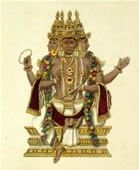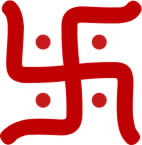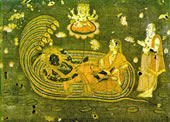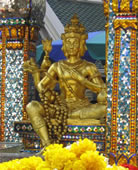

|

|

|

|

|

|

|

|
|
~~~~~~ World Bibliography of Beliefs, Theories and Theologies ~ click pix to enlarge ~~~~~~ Brahma It has been suggested that Phra Phrom be merged into this article or section. (see below) This article is about the Hindu god of creation. For the Buddhist concept, see Brahma (Buddhism). For other uses, see Brahman (disambiguation). Brahma Brahma (Sanskrit masculine brahman-, nominative brahma , personification of the neuter brahman-) is the hindu god (deva) of creation and one of the Trimurti, the others being Vishnu and Shiva. He is not to be confused with the Supreme Cosmic Spirit in Hindu Vedanta philosophy known as Brahman. Also, in Sanskrit grammar, Brahma is nominative singular of generic word Brahman, as Aatma is nominative singular for Aatman. Brahaman and Aatman are same in Vedanta philosophy, the Param-Aatma (Supersoul) and Jeeva Aatma (Individual Soul) are Brahman. His consort is Saraswati, the goddess of learning. Brahma is often identified with Prajapati, a Vedic deity. |

|

|

|

|

|

|
|
Attributes At the beginning of the process of creation, Brahma created eleven Prajapatis (used in another sense), who are believed to be the fathers of the human race. The Manusmriti enumerates them as Marichi, Atri, Angirasa, Pulastya, Pulaha, Kratu, Vasishtha, Prachetas or Daksha, Bhrigu, and Narada. He is also said to have created the seven great sages or the Saptarishi to help him create the universe. However since all these sons of his were born out of his mind rather than body, they are called Manas Putras or mind-sons or spirits. Within Vedic and Puranic scripture Brahma is described as only occasionally interfering in the affairs of the other devas (gods), and even more rarely in mortal affairs. He did force Soma to give Tara back to her husband, Brihaspati. He is considered the father of Dharma and Atri. Creation According to the Puranas, Brahma is self-born (without mother) in the lotus flower which grew from the navel of Vishnu at the beginning of the universe. This explains his name Nabhija (born from the navel). Another legend says that Brahma was born in water. In this he deposited a seed that later became the golden egg. From this golden egg, Brahma the creator was born, as Hiranyagarbha. The remaining materials of this golden egg expanded into the Brahm-anda or Universe. Being born in water, Brahma is also called Kanja (born in water). Brahma is said also to be the son of the Supreme Being, Brahman and the female energy known as Prakrti or Maya. Vishnu with Lakshmi, on the serpent Ananta Shesha, as Brahma emerges from a lotus risen from Vishnu’s navel Lack of Brahma worship in India Although Brahma is one of the major gods in Hinduism, few Hindus actually worship him. India today has very few temples dedicated to Brahmdev alone as opposed to the thousands of temples dedicated to the other deities in the Trimurti: Shiva and Vishnu. However, among those that are, the most famous is in Pushkar in Rajasthan. Others include one in Brahma-Karmali village in Sattari Taluka in Goa, one in Khedbrahma in Gujarat and one in the village of Khokhan in the Kullu Valley, 4 km from Bhuntar. There are various stories in Hindu mythology that talk of the curse that has prevented Brahma from being worshipped on Earth. At the beginning of time in Cosmos, Vishnu and Brahma approached a huge Shiva linga and set out to find its beginning and end. Vishnu was appointed the end, and Brahma the beginning. Each took their journey, Vishnu took the form of a boar and began digging downwards into the earth while Brahma took on the shape of a swan began flying upwards. But neither could find their appointed destination. Vishnu, satisfied, came up to Shiva and bowed down to him as a swarupa of Brahman. Brahma did not give up so easily. As he was going up, he saw a kaitha flower, dear to Shiva. His ego forced him to ask the flower to bear false witness of Brahma’s finding Shiva’s beginning. When Brahma told his tale, Shiva, the all-knowing, was angered by the former’s ego. Shiva thus cursed him that no being in the three worlds will worship him. A depiction of Khambhavati Ragini, A lady worshiping Brahma According to another legend, Brahma is not being worshiped due to a curse by the great sage Brahmarishi Bhrigu. Once a great fire-sacrifice (yajna) was being organised on Earth with Bhrigu being the high priest. It was decided that the greatest among all Gods would be made the presiding deity. Bhrigu then set off to find the greatest among the Trinity. When he went to Brahma, he was so immersed in the music played by Saraswati that he could hardly hear Bhrigu’s calls. The enraged Bhrigu then cursed Brahma that no person on Earth would ever invoke him or worship him again. The "officially" accepted legend of the temple at Pushkar says that in the process of a Hindu rite, Brahma was forced to marry his second wife "Gayatri" because his first wife, "Savitri" had been hoodwinked to come late by their son. Savitri thus cursed the Creator to be worshiped only there. According to Brahma Purana and Hindu cosmology, Brahma is the creator but not necessarily regarded as God in Hinduism.He is mostly regarded as a creation of God / Brahman. The lifespan of Brahma is 100 Brahma years or 311 trillion human years. At the end of his lifespan, there is a gap of 100 Brahma years after which another Brahma or creator begins anew and the process is repeated forever. For this reason, Brahma might be considered only as a creator who is the executor of the order from the Supreme being - The Brahman. Appearance A handcoloured engraving of BrahmaBrahma is traditionally depicted with four heads and four faces and four arms. With each head he continually recites one of the four Vedas. He is often depicted with a white beard (especially in North India), indicating the near eternal nature of his existence. He is shown as having four arms, with none holding a weapon, unlike most other Hindu Gods. One of his hands is shown holding a scepter in the form of a spoon, which is associated with the pouring of holy ghee or oil into a sacrificial pyre - indicating the fact that Brahma is the lord of sacrifices. Another of his hands holds a water-pot (sometimes depicted as a coconut shell containing water). The significance of the water is that it is the initial, all-encompassing ether in which the first element of creation evolved. Brahma also holds a string of rosary beads that he uses to keep track of the Universe’s time. He also is shown holding the Vedas, and sometimes, a lotus flower. Another story in connection with Brahma’s four heads is that when Brahma was creating the universe, he made a female deity known as Shatarupa (one with a hundred beautiful forms). Brahma became immediately infatuated. Shatarupa moved in various directions to avoid the gaze of Brahma. But wherever she went, Brahma developed a head. Thus, Brahma developed five heads, one on each side and one above the others. In order to control Brahma, Shiva cut off the top head. Also, Shiva felt that Shatarupa was Brahma’s daughter/son, being created by him. Therefore, Shiva determined, it was wrong for Brahma to become obsessed with her. He directed that there be no proper worship on earth for the "unholy" Brahma. Thus, only Vishnu and Shiva continue to be worshipped, while Brahma is almost totally ignored. Ever since the incident, Brahma has been reciting the four Vedas in his attempt at repentance. Vehicle See also Vimana. Brahma’s vehicle is a divine Swan. This divine bird is bestowed with a virtue called Neera-Ksheera Viveka or the ability to separate milk and water from a mixture of the two. The significance of this is that justice should be dispensed to all creatures, however entwined it might be in a situation. Also, this virtue indicates that one should learn to separate the good from the evil and then accept that which is valuable and discard that which is worthless or evil. Temples The four-faced Brahma (Phra Phrom) statueAlthough Brahma is prayed to in almost all Hindu religious rites, there are very few temples dedicated to him in India, the more prominent of which is at Pushkar, close to Ajmer. Once a year, on the full moon night of the Hindu lunar month of Kartika (October - November), a religious festival is held in Brahma’s honour. Thousands of pilgrims come to bathe in the holy lake adjacent to the temple. There are also temples in Goa, (in the small, remote village of Carambolim in the Sattari taluka in the northeast region of the state); in the temple town of Kumbakonam, (Thanjavur District) in Tamil Nadu; and in Thirunavaya in Kerala. Regular pujas are held for Brahma and during Navrathris, this temple comes to life with colourful festivities. There is also a shrine for Brahma within the Bramhapureeshwarar temple in Thirupattur, near Trichy and a famous murti of Brahma at Mangalwedha, 52 km from Solapur district in Maharashtra, the largest of which is in Angkor Wat in Cambodia. In Khedbrhama, Gujarat, there is a statue of Brahma.A six feet tall statue was also discovered at Sopara near Mumbai. Phra Phrom The four-faced Brahma (Phra Phrom) statuePhra Phrom is the Thai representation of the Hindu god Brahma. A great example of this representation is the statue of Brahma at the Erawan Shrine. Background For more than 5000 years, the disciples of Brahmana were known to have paid homage to Phra Phom as their highest esteemed God in their religion. The origin of this was that the Brahmana religion believed that these 3 Gods combined their powers to create the world. This religion was mainly symbolised by 3 major Gods: Brahma : Creator of the world and all things Vishnu : Preserver of all things Siva : Destroyer that makes all things exist and perish according to nature’s cycles The wives of these 3 Gods are also their capable assistants who also helped in the creation of the world. Brahma’s wife is known as Saraswati which means the Goddess of great wisdom. In Hinduism, Brahma is believed to be the creator of all things of the world. He is cool-tempered and possesses the highest moral principles. He is full of kindness, mercy, sympathy, and impartiality. These four precepts comprise the "Conscientious Behavior" corresponding to Buddhist teaching which instructs Buddhists of the four Dharma. Besides creating the world, Brahma also creates heaven and human beings. The features of Phra Phrom usually depict him with four faces and a pair of hands. Many people in Southeast Asia commonly refer him as the "Four Face Buddha". In fact, in the records of Buddhist literature, he belongs to the class of devas and not of the buddhas. The significance of the four faces of the Brahma were to offer help to the people who come to him from all directions. It is also believed that there are special significance to the religions items held by the hand and its posture. The significance of the items interpreted are believed to be as follows: Sutra: Represents knowledge Beads: Controlling karma Spear: Will power Flower vase: Wish fulfillment Conch shell: Wealth and propserity Mystic position of hand placed on the chest: compassion Flying wheel: To avert disaster and calamities, suppresses evil. Cintamani: (a kind of fan used by monks for blessings): Power of blessings. Gifts Worshippers of Phra Phom usually offer jasmine flowers or jasmine garlands and young coconut milk (with water in them) in their worship. Another common way of worship is to place wooden elephant statues on the altar to honor him. Phra Phrom is also known to admire Thai classical music, which is played near the altar, accompanied by dancers. Worshippers of Phra Phrom are also usually advised to abstain from consuming meat. See also Brahma (Buddhism) Phra Phrom God of Creation Brahmastra Demiurge Erawan Shrine Narada Muni Hindu deities |
©